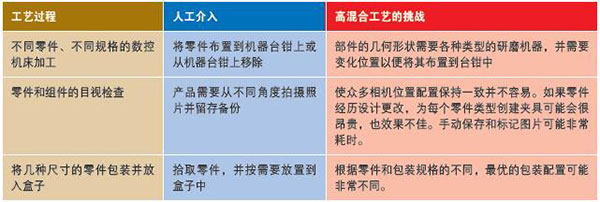News Center

Under the environment of increasingly fierce market competition, there is continuous pressure on manufacturing enterprises in terms of price reduction and operational efficiency improvement. If only one product is produced, it is easy to determine where improvements in the process can improve efficiency. However, if several different products are produced at the same time, just improving one process may not have a significant impact on the return on investment.
High hybrid plants produce many different parts simultaneously, each with a different manufacturing process, such as CNC machining, stamping, visual inspection and picture archiving. All of this requires some degree of human involvement (loading/unloading parts, packing parts, taking and saving pictures, etc.). Overhauling automated processes can be costly, and low or unpredictable quantities for any one component can make unit costs huge, making decisions difficult for management. Adding automation to highly mixed production processes is challenging. The foundation of any highly hybrid operation is the concept of transition time. Any effort toward automation must take into account the non-value-added time associated with transformation, or eliminate them altogether. With that in mind, here are the possible paths to automation in a highly mixed environment.

The challenge of improving high-mix production lines
For traditional fixed automation systems, the options available are almost endless, including industrial robots, gantry cartesian robots, conveyor belts, and even turnkey machines designed by integrators. Such solutions are usually fixed for the control of multiple products in one or mixed production.
On the positive side, the "tailor-made" nature of such solutions means that they tend to be very effective for the process of deploying it. If the cycle time must be much less than 2 seconds, then traditional automation may be the easiest way to improve the process flow.
However, in a highly mixed environment, fixed automation often means a decision between a lower capital investment (involving only a few products) or a higher capital investment (being able to handle all of the company's products). Traditional systems are often designed with a focus on yield rather than speed and flexibility, so tool transitions can take considerable time, especially when security protocols require physical separation from people. The total cost of ownership is often high when considering the security equipment, footprint, and setup required for traditional security approaches. In any case, this prolongs the return on investment cycle in a high-mix environment, especially when yields are relatively low.
robot-as-platform
Robot as a Platform (RaaP) solutions can be as diverse as a company's product lineup, and they all have one thing in common: robots as part of a system designed for rapid redeployment. In traditional deployment methods, robots are part of a specific process, while the robot as a Platform (RaaP) enables robots to move anywhere on a given day, depending on production needs.
The ideal solution in a highly mixed environment should have the ability to quickly switch from one application to another in the shortest possible conversion time. This minimizes conversion times that add no value and can make traditional automation prohibitively expensive.

For highly mixed scenarios with a high degree of manual involvement, it is best to view the cobot solution as a standalone or as part of a platform. Both platforms can be positioned precisely where they are needed to expand existing capacity, while allowing for rapid conversions that improve ROI and shorten payback periods.
Highly mixed production environments can be difficult to improve quickly. The ideal improvement would involve multiple production lines, but the investment required to adapt multiple processes can be large enough to significantly reduce the return on investment. Traditional automation is undoubtedly a more efficient solution for high volume or rapid cycle production.
(Source: Control Engineering Network)
Return to Overview